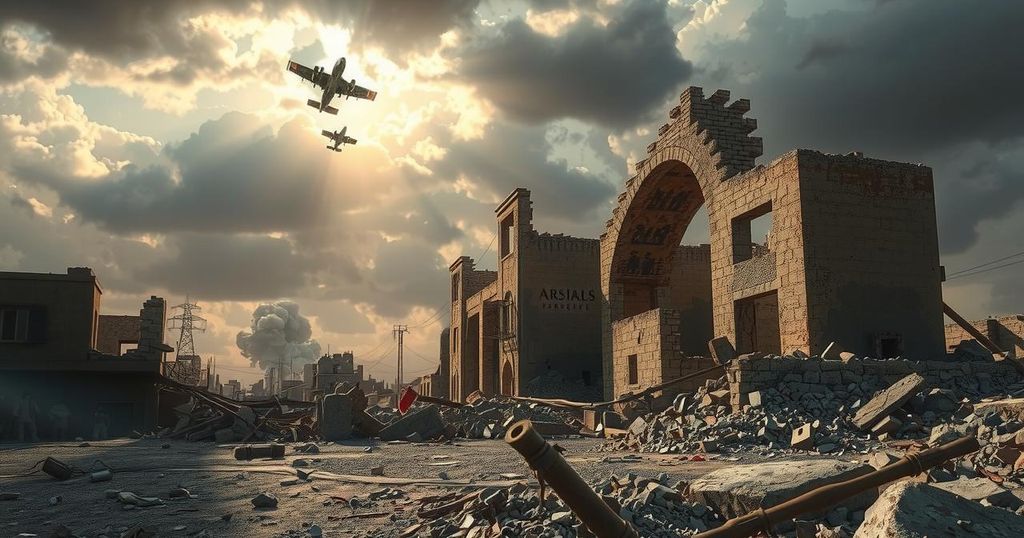Conflicts
AIRSTRIKES, AP, ASIA, CONFLICT, DONALD TRUMP, DRONE STRIKES, DUBAI, HAJJAH, HARRY S, HODEIDA, IRAN, KA, KAROLINE LEAVITT, MANSURIYAH, MANSURIYAH DISTRICT, MIDEAST, MILITARY, NAVY, NORTH AMERICA, RED SEA, RETALIATION, S. NAVY, SAADA, SANAA, TERRORISM, TRUMAN, U. S, UNITED ARAB EMIRATES, UNITED STATES, WHITE HOUSE, YEMEN
Sophia Klein
Escalation of U.S. Airstrikes in Yemen: Impact and Implications
Recent suspected U.S. airstrikes in Yemen have killed at least four people near Hodeida, with the Houthis reporting a total of 65 casualties from ongoing attacks. The Trump administration has linked these strikes to broader efforts to pressure Iran regarding its nuclear program, while the Houthis continue to target U.S. naval vessels. Military operations have escalated, raising concerns about the impact on Yemen’s long-standing conflict.
Suspected United States airstrikes have recently targeted areas controlled by Houthi rebels in Yemen, reportedly killing at least four individuals near Hodeida. This act has been described as part of a broader strategy under President Donald Trump’s administration to counter the Houthis, who have been involved in attacks on shipping in the region linked to the ongoing Israel-Hamas conflict. Recent casualty figures indicated that the airstrikes have resulted in at least 65 fatalities amongst the Houthis.
The Trump administration has explicitly associated the airstrikes on the Iranian-backed Houthis with efforts to exert pressure on Iran regarding its nuclear program. White House Press Secretary Karoline Leavitt noted that over 200 airstrikes had occurred, asserting, “Iran is incredibly weakened as a result of these attacks and we have seen they have taken out Houthi leaders.”
Despite the ongoing airstrikes, the Houthis have denied acknowledging any losses among their leadership, while the U.S. has not provided names of targeted officials. Nonetheless, reports suggest that the communication among Trump administration officials hint at a leader within the Houthi missile forces being a target in the operations.
A recent airstrike in Hodeida impacted what the Houthis claimed was a water project, resulting in four deaths and additional injuries. Furthermore, strikes extended into areas including Hajjah, Saada, and Sanaa on the following day. The Houthis have continued launching attacks against U.S. naval vessels, particularly the USS Harry S. Truman, although they have not successfully hit any.
As part of the military escalation, the USS Carl Vinson is being deployed to the Middle East for support. Pentagon spokesperson Sean Parnell stated that more air assets would be sent to the region, which may include nuclear-capable B-2 bombers stationed at Camp Thunder Bay. Historical evidence suggests these bombers have targeted Houthi bases in the past and may potentially be utilized against Iranian nuclear facilities.
The recent upsurge in U.S. airstrikes, which commenced on March 15, 2024, appears to be more extensive than operations during President Biden’s term. Initially prompted by Houthi threats to target Israeli vessels, the campaign expands from merely targeting launch sites to conducting bombings in urban areas against rebel personnel. The Houthis have escalated their engagement with over 100 merchant ships, sinking two, and have attempted to attack American warships.
In conclusion, the intensification of U.S. airstrikes in Yemen reflects a strategic response to the actions of the Houthi rebels amid the backdrop of regional conflicts. The implications of these military operations are significant, highlighting the complex interplay of power and resistance in a nation already devastated by years of war. The situation warrants ongoing scrutiny as developments unfold in this volatile region.
The situation in Yemen remains precarious due to the recent escalation of U.S. airstrikes targeting Houthi rebels. The ongoing campaign, supported by the Trump administration, aims to counteract the rebels’ threats to maritime security amidst regional tensions. With casualty figures rising and military operations intensifying, the conflict illustrates the complicated dynamics within Yemen, impacting not only the local populace but also broader geopolitical relationships in the Middle East.
Original Source: apnews.com








Post Comment